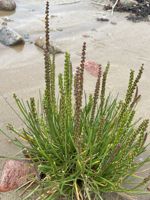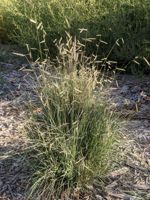Mon-Fri 9am - 5pm Mountain time
Seaside Arrowgrass vs Blue Grama Grass
Triglochin maritima
Bouteloua gracilis
CUSTOM GROW
NOT AVAILABLE THIS SEASON - MIGHT RETURN
Seaside Arrowgrass is a native perennial commonly found in wetlands, salt marshes, and moist meadows. It is especially suitable for difficult growing sites. Its dense root system helps stabilize soil, while also providing food, cover, and habitat for small animals within the wetland community.
Seaside Arrowgrass is suitable for shoreline stabilization, wetland restoration, and naturalization projects.
Blue Grama is a native perennial bunchgrass recognized for its blue-green blades and unique seed heads. They grow along one side of the stem and are often compared to eyelashes, eyebrows, or mosquito larvae, which inspired its common names, Eyelash Grass and Mosquito Grass. As the seed heads begin to dry in the fall, they curl, further enhancing the plant’s distinctive appearance. The seeds provide food for birds, and the grass serves as a host plant for certain species of skipper butterflies.
As a warm-season grass, Blue Grama has a slow start in spring and does not actively grow until soil temperatures rise. Its deep roots help with erosion control, and the grass is drought-tolerant once established, thriving even in poor or alkaline soils. It is well-suited for soil stabilization, naturalization, restoration projects, or as an ornamental accent in gardens and landscapes.
Seaside Arrowgrass Quick Facts
Blue Grama Grass Quick Facts
Toxicity: can be toxic to humans and livestock

